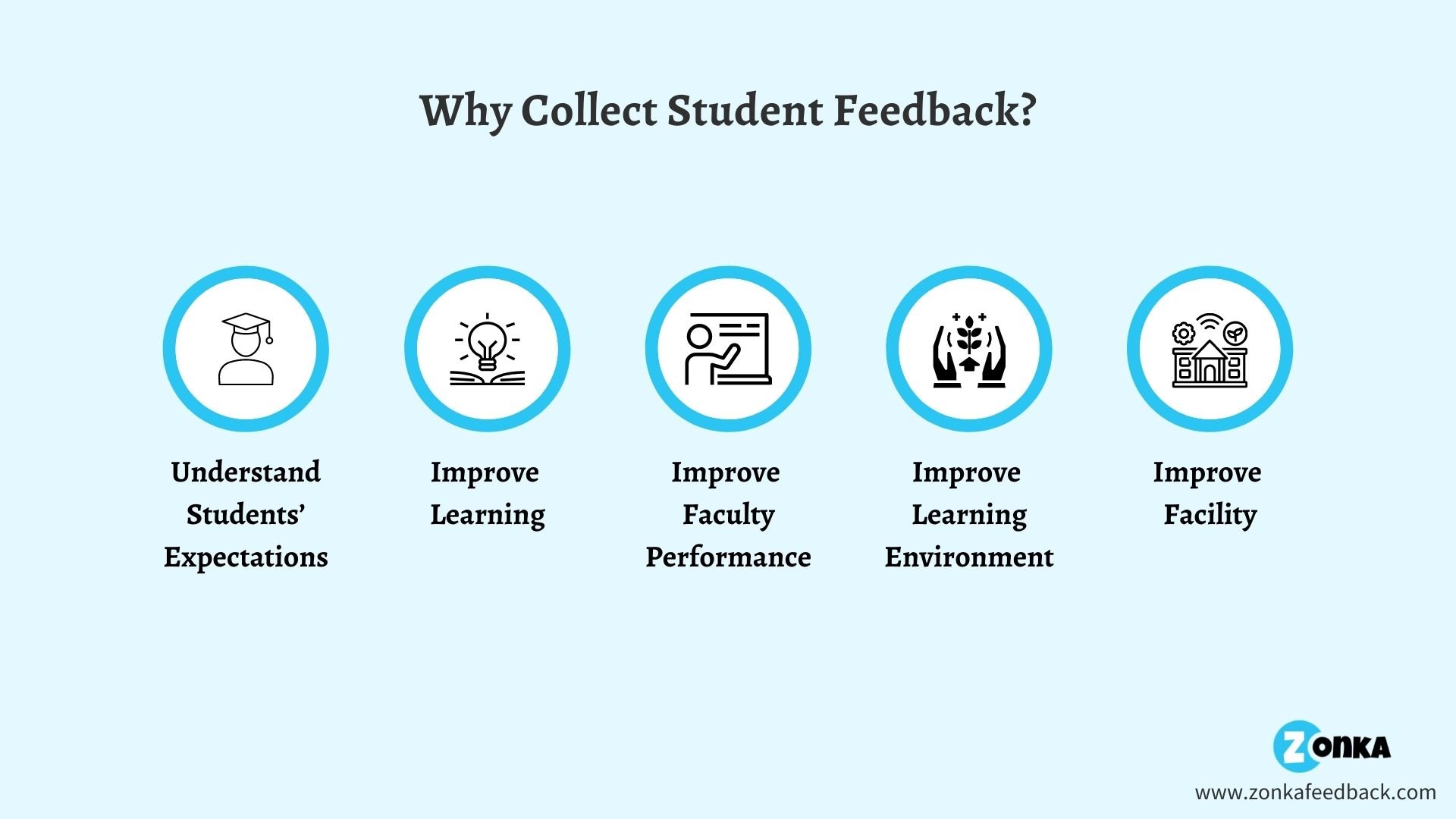According to research by Grattan Institute, a well-developed strategy to collect student feedback can improve teachers’ effectiveness by 20-30%. And how students are taught has a direct impact on their academic performance and overall success.
Transform Academic Experience with Student Feedback👩🎓
Build student-centric surveys to get real-time feedback and enhance knowledge influx and student engagement with data-driven teaching.

Be it universities, coaching organizations, or colleges, you can collect student feedback around the quality of seminars, study material, projects, teaching strategies, etc. using student feedback software. And this data can further be used to train teachers, improve study material, optimize schedules, and enhance overall outcomes in your educational institute.
Let’s understand in detail why and how to collect student feedback.
Why Collect Student Feedback?
Student feedback can be extremely helpful in improving all aspects of education. Here's you can leverage it:
1. Understand Students’ Expectations
Feedback is generally perceived as relevant after the completion of a course or semester. But once a certain course ends, students are all prepared to put it behind them. So, instead of waiting till the end of the semester or year, understand students’ expectations at the beginning using pre-course surveys or other feedback collection methodologies. Communicate to students how you’re planning to use their feedback to improve the course or learning strategies before the semester starts.
Here are some of the elements you can take feedback on:
- Understanding of the course syllabus or curriculum
- Lecture scheduling
- Preferred learning styles
- Students’ previous knowledge in the subject area
- Expectations from teachers
Note: Make sure to ask your students to share their expectations in their own words through open-ended questions.
2. Improve Learning
Course, classroom educational devices and resource effectiveness have a direct impact on students’ performance and progress. And who best to take feedback about the course from than the students. So, conduct student feedback to check how effective your study material and training resources are.
You can understand this in the first two or three months of a semester or year, and use the feedback data to substantially improve resources you have control over, such as:
- Study/training material
- Lab activities
- Experimental learning
- Frequency of student-faculty interactions
- Structure of class diagram
- Workload
3. Improve Faculty Performance
According to a report by the RP Group, CA, students must exhibit Six Success Factors – Focused, Directed, Nurtured, Engaged, Connected and Valued. And the success of faculty is attributed to their ability to help students achieve these success factors.
You can understand how effective teachers are and attain excellent teaching standards by conducting student feedback. With the medium of SMS or email surveys and other feedback programs, they can directly share what can improve their learning, and thereby, performance.
You can conduct student feedback to assess these important metrics:
- Teachers’ accessibility & approachability
- Knowledge and teaching style
- Pace of teaching
- Communication
- Readiness to answer questions
- Willingness to solve queries
- Willing to offer feedback
- Fairness and equality
- Helpfulness
4. Improve Learning Environment
The learning environment has an indispensable role to play in students’ learning and academic success. According to Springer Link, we can see a shift in the kind of learning environment preferred by students. The development of the learning environment is key to achieving higher education standards in universities. And though you can welcome and facilitate important changes, it is always wise to measure the potential and outcome of your strategies by collecting student feedback.
You can use student feedback data to measure their perspective around:
- Support by the management
- Action on student feedback
- The flexibility of learning opportunities
- Peer support
- Emphasis on students’ mental health
- Fairness and equal participation
- Social development opportunities
- Financial flexibility
- Reward and recognition
5. Improve Facility
Feedback on the facility can often go unnoticed but can have a great impact on the effectiveness of your education system. After all, students' ease and comfort can have a significant effect on their mood and health. So, collect feedback of students for the facility around elements, such as:
- Infrastructure
- Transport
- Spaciousness
- Seat and class allotments
- Cafeteria
- Security

How to Collect Student Feedback?
Student feedback can be taken at different touchpoints through different methodologies. You can either use a single methodology or combine different ones depending on your goals and objectives.
Let’s understand how you can collect student feedback.
1. Modify Formative Assessments
Colleges and universities use formative assessment strategies to assess learning mid-project or mid-semester. You can use this technique to gather feedback on classes, faculty’s teaching style, pace, and accessibility to experiment with the learning techniques and optimize them to align students’ strengths.
Why Formative Assessments?
Students are usually familiar with formative assessments. By modifying formative assessments to collect feedback from students, you can gather detailed feedback from time to time.
2. Use Student Feedback Surveys
Student feedback surveys are a great way to understand students’ satisfaction with the course, teaching methods, faculty, learning environment, and the facility. With a good student survey tool, you can easily create surveys using templates and share them digitally. And this is not only an effective feedback collection strategy but also a time-effective means to understand students better.
Why Student Feedback Surveys?
-
A feedback survey can be shared through any medium, including email, SMS, mobile, tablet, kiosk, website, mobile app, web link, QR code, and live chat.
-
Thousands of students can take a survey simultaneously, which is certainly more efficient in terms of time and ease.
-
Survey outcomes can be viewed in insightful reports.
-
Digital surveys can be conducted anonymously, encouraging more honest feedback.
-
Digital surveys are easier to conduct and can be taken on the go, which can significantly improve the participation rate.
3. Conduct Group Discussions
You can have detailed discussions about practices like how to find grading scale and ideas that can improve students’ learning and academic outcomes. For example, you can discuss if students would learn better with peer groups and come up with a plan together. Similarly, you can conduct polls and see which teaching style or course material is more helpful.
Why Group Discussions?
Group discussions allow connecting with students face-to-face. Moreover, discussions can make students feel more comfortable in putting their views forward.
4. Create a Student Feedback Portal
Creating a student feedback portal is a great way to encourage students to share feedback any time they want. However, it is not a structured feedback methodology since you may or may not receive quality feedback. Student complaint/suggestion portals can add value to your feedback program if used in combination with other more structured feedback techniques.
Why Student Feedback Portals?
Student feedback portals have are open 24x7, which can be encouraging for students to share feedback as soon as they come across a challenge.
.jpg?width=1920&name=Student%20Feedback%20(1).jpg)
Student Feedback With Zonka Feedback Survey Tool
Surveys are the most effective tool when you’re looking to collect feedback at scale. And the Zonka Feedback survey software is designed keeping the needs of an educational institute in mind. Here’s how our survey tool enables you:
- Create different surveys throughout the year using customizable education feedback form templates.
- Share surveys through all digital channels, including mobile, tablet, SMS, email, mobile app, kiosk, website, live chat, and QR code.
- Create reports easily with our reporting and analysis tool to get a birds-eye view of student feedback data.
- Set up alerts and reminders for different stakeholders.
- Receive responses in real-time.
- Apply survey logic to make your surveys more relevant.
Student feedback can help you in changing the dynamics of your education system in the most wonderful way. All you need is the right feedback collection strategy and resources to act on the feedback quickly.
.jpg)



.png)


.jpg)
.jpg)
.jpg)

.jpg)